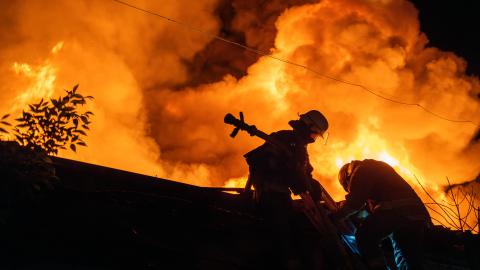Below Hudson Senior Fellow Can Kasapoğlu offers a military situation report about the war in Ukraine.
Executive Summary
- The Russian military initiated a blitz assault on Kharkiv, testing Ukraine’s combat performance and defensive depth. One should not take the Kharkiv offensive lightly. The campaign could turn into a main capture effort rather than a subordinate one that merely aims to disrupt Ukraine’s economy of force.
- In Donetsk Oblast, the Russian invasion has been pushing hard to capture Chasiv Yar, while capitalizing on the operational success in Ocheretyne. On the eastern front, the Russian military’s chief aim is to control the land lines of communication.
- Ukraine’s new military strategy of targeting Russia’s oil refineries began to pay off, hampering the Kremlin’s ability to fund its military.
- Moscow continued to turn the Russian Republic of Tatarstan into a drone production hub, using abusive child labor to build robotic assets there.
1. Battlefield Assessment: Russia Renews Its Push in Kharkiv
Russian forces have renewed their push for the Ukrainian city of Kharkiv in an initial assault featuring numerous midsized, tactical infantry units backed by heavy armor and artillery.
Neither Moscow nor Kyiv fully controls the border area between Kharkiv and the Russian city of Belgorod. Anti-Kremlin Russian armed groupings and Chechen formations have raided Belgorod from Ukraine multiple times. Open-source data also suggests that this border area is poorly fortified, with Ukraine’s lines of defense situated deep inside its own territory. This defensive architecture, which Kyiv has optimized to manage its limited manpower, has enabled Russian units to progress quickly after their initial incursion.
As a result, the Russian military has secured tactical gains that it will likely attempt to parlay into permanent strategic advances, possibly placing the outskirts of Kharkiv in the range of its tube artillery. In the coming days, Russia may add units in the area and seek to advance further into Ukraine. Meanwhile, Hudson’s digital open-source intelligence (OSINT) monitoring has detected numerous engagements that suggest Ukrainian first-person-view (FPV) drones have started intensively preying on Russian armor. At present, the political-military scope of the Russian offensive and the state of the conflict on the front line remain unclear.
Moscow’s forces, which are roughly equivalent in size to two Russian corps, are prepared to maintain their current operation, though they have not yet challenged Ukraine’s primary defenses in the area. Rather than seizing Kharkiv, the Kremlin may use its operations in the city’s outer ring to disrupt the Ukrainian military’s economy of force. Russia’s efforts could compel Ukraine to defend Kharkiv by reallocating combat formations from the front lines around Donetsk and Luhansk in the east.
Yet Russia may not need to choose between taking Kharkiv and advancing in the east; it may be able to land knockout punches on both fronts with a precise military strategy. With favorable force-on-force and force-to-terrain ratios stemming from its manpower advantage—and the potential to bolster its current arsenal by 15,000 to 20,000 artillery rounds per day—the Russian military can exert pressure along multiple axes.
This places the Ukrainian Armed Forces in a difficult position. Available intelligence suggests that the current Russian military presence in Kharkiv comprises around 50,000 personnel, a powerful concentration of fire-support assets, and hundreds of armored platforms, including main battle tanks. Russian units can push for Kharkiv and Donetsk Oblast simultaneously if the high command in Moscow plays its hand carefully and focuses on capturing highways in the east while gradually amassing troops around Kharkiv.
Recently, Russia’s combat operations in Donetsk Oblast have centered on Chasiv Yar and Ocheretyne, considering these towns as stepping stones to flow into deeper Ukrainian territory hosting critical highways. Overall, the Kremlin’s military strategy in Donetsk is centered on expanding its critical lines of communication. Recent reports suggest that Russia has captured Ocheretyne; if true, Russia’s penetration of Ukraine’s lines of defense occurred remarkably quickly. Chasiv Yar, where Moscow has recently increased its offensive activity, remains heavily contested.
Should Russian forces place additional Ukrainian infrastructure and transport nodes under fire control, the Kremlin could decide to invade Kostyantynivka, a valuable hub town. Russian units have already made inroads to that end, conducting fierce battles and heavy shelling in contested areas.
Accompanying this heavy push on the ground, Moscow has also been conducting drone and missile strikes on Ukrainian cities and energy infrastructure. The General Staff of the Armed Forces of Ukraine reported that on May 9 alone, Russia conducted over 70 air and missile strikes on Ukrainian fortifications and urban centers, damaging civilian infrastructure and inflicting casualties throughout the country.
Meanwhile, Moscow continues to engage in nuclear saber-rattling. The New York Times reported that Belarus is currently upgrading a munitions depot for the storage of Russian tactical nuclear weapons; the facility also reportedly hosts Belarusian Iskander missiles equipped with nuclear payloads. This development poses a direct threat to the North Atlantic Treaty Organization and reflects the Kremlin’s escalating nuclear rhetoric against Ukraine and the West.
2. Ukrainian Forces Continue to Target Russia’s Oil Refineries, Impeding the Kremlin’s Ability to Fund Its Military
Last week, Ukraine continued striking Russian energy facilities as part of a concerted strategy to limit Moscow’s ability to fund its war. Vadym Skibitsky, the deputy head of Ukraine’s Main Directorate of Intelligence (GUR), stated that the strikes are intended as a response to Moscow’s attacks on Ukraine’s energy network and civilian population.
Geosatellite imagery suggests that on May 9, Ukrainian forces used a full-size light sport aircraft, modified to fly uncrewed, to strike a major oil refinery in the Salavat region of the Republic of Bashkortostan, 930 miles inside Russia. Ukraine’s concept of operations (CONOPS) for this strike mirrors its recent attack on the joint Russian-Iranian drone manufacturing plant in the Russian Republic of Tatarstan. In this strike, Kyiv used an Aeroprakt A-22 Foxbat modified for unmanned strike roles to penetrate Russian air defenses. Ukraine also launched a drone attack on the Pervyy Zavod refinery in Kaluga Oblast, 220 miles inside Russia, inflicting further attrition on Russia’s energy generation capabilities.
Kyiv’s sustained attacks on Russian energy infrastructure could have dire consequences for the Kremlin. The strikes could force Moscow to transfer its air defense systems away from the front lines in order to protect its most lucrative sources of income, and could also delay Russia’s oil exports.
Continued attacks would also prove that Ukraine can circumvent enemy air defenses and penetrate deep within Russian territory. Damaging hits on Russia’s energy infrastructure have already weakened the Russian economy, eroding around 10 percent of its oil refinery capacity and reducing its daily oil production.
3. Drone Warfare Continues to Drive the Conflict
Ukraine has continued to benefit from its innovative use of unmanned aerial vehicles (UAVs) in the maritime domain. By equipping its naval drones with Soviet-era, short-range, air-to-air R-73 Archer missiles, Kyiv is now upgrading its unmanned surface vehicles’ (USVs) capabilities. These USVs are now flexible platforms that can intercept the Russian Navy’s helicopters over the Black Sea at low altitudes.
Russia is also investing heavily in boosting its counter-drone capabilities. Visual evidence suggests that Project Archangel, a Russian volunteer group working on drone warfare solutions, is currently developing a lightweight net to hunt down Ukrainian UAVs. Online footage of a recent live test of this device indicates that Russia is using a commercially available Chinese Mavic rotary-wing mini-drone to carry the net.
Following the establishment of the joint Russian-Iranian drone production plant in Tatarstan, new defense technology initiatives are mushrooming in the region. For some time, Russia has been exploiting the indigenous children of Tatarstan and using them to fill its drone production workforce.
Visual evidence suggests that an unidentified new company has begun to develop cost-effective intelligence, surveillance, and reconnaissance (ISR) combat drones for Russian forces. One of the company’s projects, dubbed Tatar, is a less expensive version of Russia’s Supercam UAV and can be mass-produced. Russian Telegram users suggest that the drone possesses an operational range of over 12 miles and is designed to be user-friendly and rapidly deployable. The Kremlin now benefits from multiple companies that produce budget-friendly unmanned aerial solutions designed to overwhelm Ukraine’s air defenses and damage its infrastructure.













